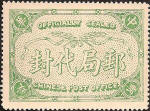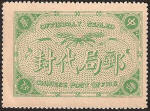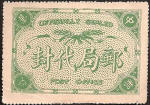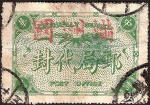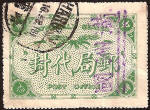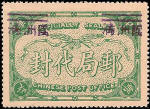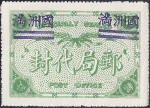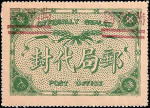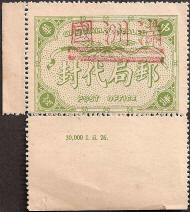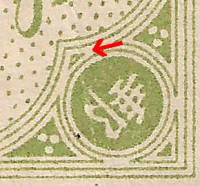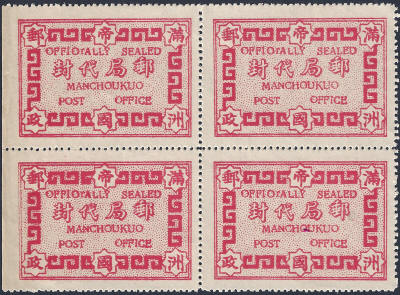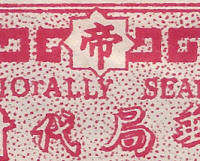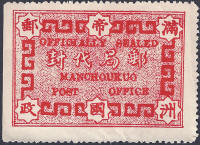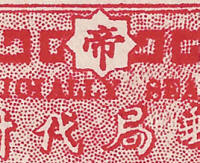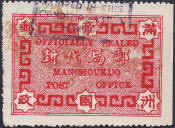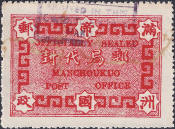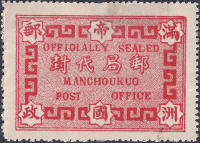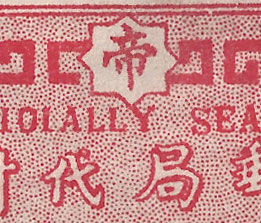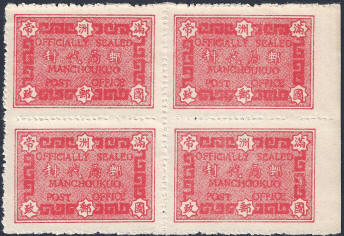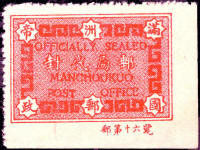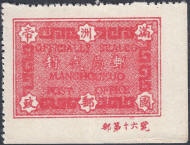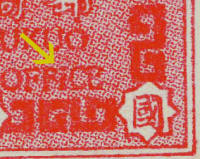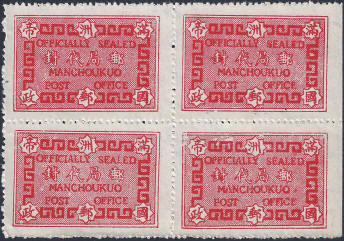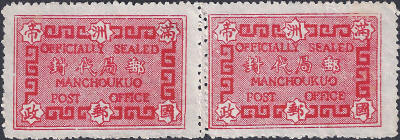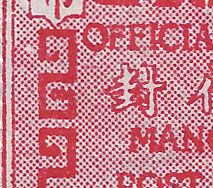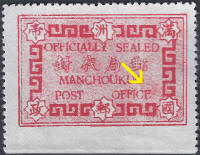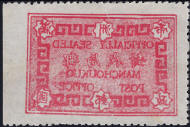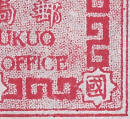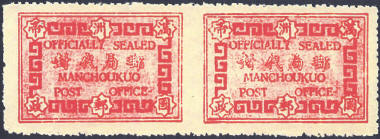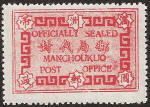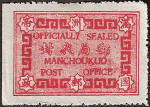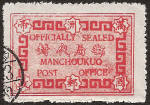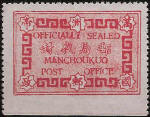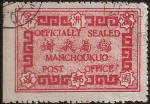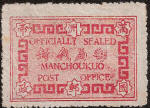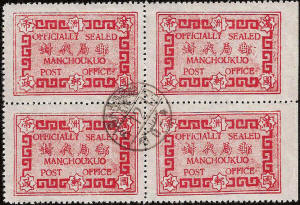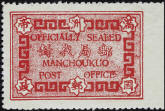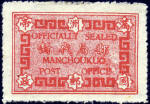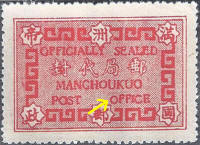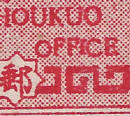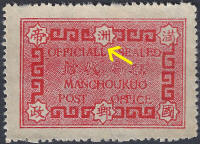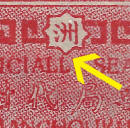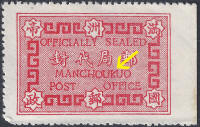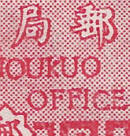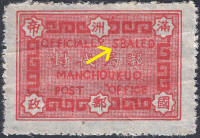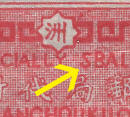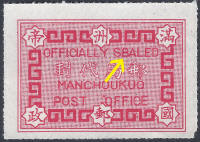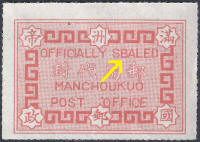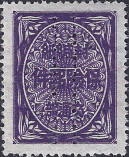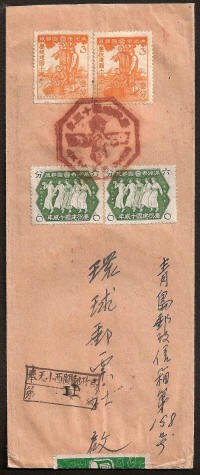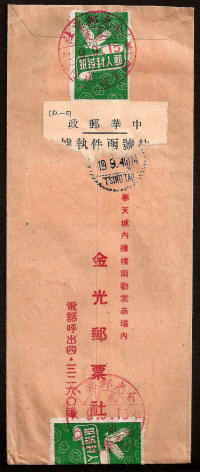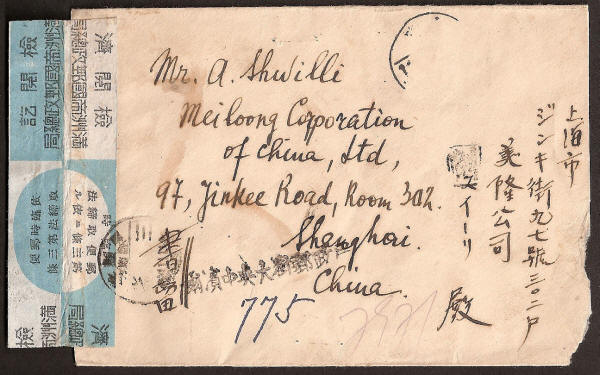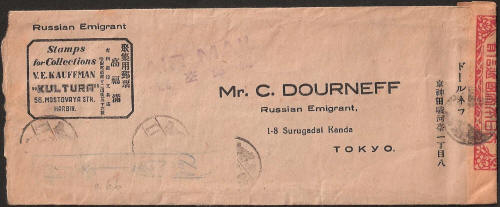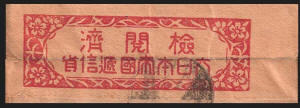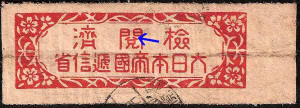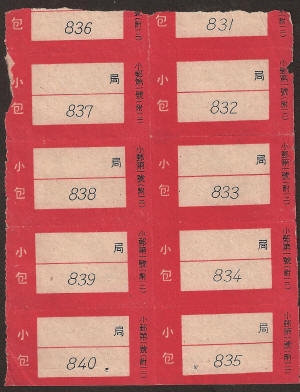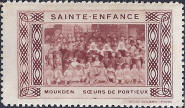 |
||||||||
|
|
||||||||
|
|
Chinese Officially Sealed Labels with Provisional Overprints In 1932 when the Japanese seized Manchukuo, Post Offices used existing stocks of blue/green 1916, 1923 and 1928 Chinese "Officially Sealed" labels. The seals were used on letters or parcels that were received unsealed at the post office, damaged in transit, or opened in error. The earlier labels have the words "CHINESE POST OFFICE" at the bottom, in later labels this was modified to simply read "POST OFFICE". All labels have the four central characters 封成局郵 meaning Post Office Official Seal. These seals were treated as post office forms and given the reference "(D-197)" this appears in the margin at on the top left hand corner of the sheet. 1916-1922 1922-1929 1928-1932 A range of provisional overprints exist, these include chops with three, four or six characters' no bars, one bar, two bars, four bars or five bars and sometimes the overprints are applied sideways or twice on a label. These overprints appear either in vermillion, mauve or black and the chops were probably made locally. Most feature the three characters "Man-Chou-Kou" "國洲滿". The labels are associated with the towns of Harbin and Mukden and also Kirin Province. The overprints occur only on the above three types. |
|||||||
|
Above are two examples of the Kirin overprint on 1928 labels. Harbin overprint on 1916-1922 label in purple (inverted) and on 1928 labels in purple and red/brown. Beware Forgeries Genuine examples of the provisional labels are hard to find and expensive. Forgeries occur frequently on internet auction sites, of particular concern is a dealer in Beijing trading with at least two user names from the same premises. A sample of these forgeries can be seen here. It is hard to tell the real item from the many fakes so always deal with someone you trust. This example is typical, in this case the Kirin chop has been applied to a Yellow Green Seal. Take a close look, these can be identified by the small corner triangle. There is no record of this seal having been overprinted and the above is a fake. |
||||||||
|
|
||||||||
|
Manchukuo Red Officially Sealed Labels From 1934 onwards Manchukuo issued its own “Officially Sealed” labels. The labels are carmine in color, sometimes with a hint of orange. All are printed on white, un-watermarked paper. Prior to 1934 remaining stocks of the green labels of the Republic of China were overprinted in black, violet or red reading 國洲滿 (Manchukuo). Design work may have started on the new red seals towards the end of 1933 (as Schumann suggests) but they would not have been issued until Manchukuo became an empire on March 1, 1934 (see the previous section). When designing the new red labels they retained the earlier Republic of China format. They feature the same four central characters reading 封成局郵“Post Office Official Seal”, with six characters 政,郵,國,帝,洲,滿 "Manchu State Empire Postal Administration" each of these characters is enclosed within a star shaped design. These seals were used in Post Offices to re-seal open envelopes and repair damaged parcels. The seal was then cancelled with a post office date-stamp to tie the label to the letter or parcel. Presumably this was a security measure. Sometimes an additional boxed hand-stamp was applied giving an explanation such as “Arrived in this Condition at P.O. Harbin” Later seals were probably produced, as needed, by local printers, these have yet to be identified. Covers with seals are scarce making the dating of later issues very difficult. Differences are often small, so a yellow arrow has been used to highlight distinctive characteristics on some labels.
MROS 1 Figure MROS 1 Detail 1934 Litho printed in sheets of 50 by the Central Bank of Manchukuo Printing Office in Hsinking. Note the lightly dotted background. Officially appears as OFFIOrALLY. Offsets are known. Large size, 51mm x 35mm. Perf 11. Issued on white wove paper, no gum. Schumann lists these seals as having been issued in 1933, however as the seal shows the six characters 政郵國帝洲滿 "Manchu State Empire Postal Administration" it is unlikely that this seal was in production before early 1934 and certainly it cannot have been in use before March 1934 (when Puyi became Emperor and Manchukuo became an Empire).
MROS 2
|
||||||||
|
Figure MROS 2 Detail 1934 Litho printed in sheets of 50 by the Central Bank of Manchukuo Printing Office in Hsinking. This label is nearly identical to MROS1 but has a more heavily dotted background. Officially can appear either as OFFICIALLY or OFFIOIALLAY (MROS 2a) but in this instance the cause is a closed “C” not the wrong use of a letter “O”. Large size, 51mm x 35mm. Perf 11. Issued on white wove paper, no gum. Note: Proofs were printed in black, imperf.
|
||||||||
|
Two examples with the boxed hand-stamp reading "ARRIVED IN THIS CONDITION P.O. HARBIN" MROS 3 Figure MROS 3 Detail 1934 Litho printed in sheets of 50 by the Central Bank of Manchukuo Printing Office in Hsinking. The central star (top) is below the frame. Officially is again shown with the closed “C” OFFIOIALLY spelling. Large size, 51mm x 35mm. Perf 11. Issued on white wove paper, no gum.
|
||||||||
|
MROS 4 Figure MROS 4 Figures MROS 4 & MROS 4a Small “i” 1935/6 Litho printed in sheets of 50 by the Central Bank of Manchukuo Printing Office in Hsinking. The background has a cellular look and the color is variable, it can appear pale or dark, sometimes red-orange. There are two distinct printings, the first is set with a lower case “i” in OFFICE (MROS 4) while a later version has a capital “I” (MROS 4a). The imprint appearing at the bottom right hand corner of each sheet reads 郵第十六號 "Postal Number 16." This is in a slightly different position depending upon the setting. Small size, 43.8mm x 29.5mm. Rough Perf 10.5. Issued on white wove paper, no gum.
MROS 5 Figure MROS 5 Figures MROS 5a (Double Perf) Detail 1936 To distinguish this seal from MROS 6 and MROS 8 note that the RH vertical stroke of the “封” (Feng) is directly above RH leg of the “M”. Unlike MROS 4 it has a background of regular dots. There are two versions of this label. The first is on thin paper using colorfast ink MROS 5, the second is on thicker paper printed using a fugitive ink (soluble in water) MROS 5b. 50 labels per sheet, Perf. 10.75, no gum. Size 44mm x 29.5mm.
MROS 6 Figure MROS 6 MROS 6a Offset Disturbed Background MROS 6b Imperf Pair 1938 Litho printed in sheets of 50 by the Manchukuo Government Supplies Division, Hsinking. Look for the disturbed background above the “E” in OFFICE. Note that the character “國“ Kou, is different for possibly each stamp in the sheet of 50, this can be confirmed when a full sheet is discovered (see below). Varieties include stamps imperf between horizontal pairs MROS 6b and a “mirror” offset MROS 6a. Small size, 44mm x 29.5mm. Perf 10½ good to rough. Thin white paper, no gum.
Variety "a" Variety "b" Variety "c"
Variety "d" Variety "e" Variety "f" Variety "f" Variety "g" Variety "a" Variety "h" Variety "i" Variety "j" Variety "k So far a total of thirteen different varieties of this label have been identified These varieties are based upon differences in the square "Kuo" character in the bottom right hand star.
MROS 7 Figure MROS 7 Position of "O" Issue Date Unknown Litho printed in sheets of 50 by the Manchukuo Government Supplies Division, Hsinking. Note the regular screen of dots in the background and the low position of the “O” in OFFICE. Proofs were printed in black, imperf. Small size, 44mm x 30mm, Rough Perf 10.5. Thick white paper with a close screen pattern on the reverse side. ,no gum.
MROS 8 Figure MROS 8 Detail Issue Date Unknown Similar, but not identical to MROS 4. The background of this label has a cellular look with the dots arranged in circles. It is the only label in this series where the lower point of the top central star is above the last “L” of OFFICIALLY and not above the “Y”. Printed in sheets of 50. Perf. 10.5, Thick white paper, no gum. Size 44mm x 30mm.
MROS 9 Figure MROS 9 Small “k” Issue Date Unknown This is a well printed example with a regular dotted background. Look for a small "k" in MANCHOUkUO. The size is also unique. Litho printed. Small size, 44mm x 29.5mm. Perf 10.75. Thin smooth paper, no gum.
MROS 10 Figure MROS 10 Detail Issue Date Unknown This label reads "OFFICIALLY SBALED" with a low “S” and has smaller characters in the stars. Note also the accent on the “O” in ‘OFFICE. 50 labels per sheet. Rough perf 10.25. Thin smooth white paper, no gum. Size, 44mm x 29.5mm.
MROS 11 Figure MROS11 Figure MROS11a Issue Date Unknown All off these stamps read OFFICIALLY SBALED, the “S” is aligned with the other letters unlike MROS 10 which is similar in design and perforated. Note also the accent on the “O” in ‘OFFICE. 50 labels per sheet. Rouletted 12, Thin paper, no gum. Size 44.5mm x 30mm. |
||||||||
|
|
||||||||
|
|
||||||||
|
Manchukuo Postal Insurance Seals Size 21mm x 27.5mm, Perf 12 x 12.5mm with gum. Full sheets of 50 labels have an imprint of 14 characters 大日本帝國國政府内閣印刷局製造 which read "Manufactured by the Imperial Japanese Cabinet Printing Bureau" (Dainippon Teikoku Seifu Insatsukyoku Seizō) similar labels are made by this bureau for use in Japan. These seals are unique in having two rows of 17 central perforations (12.5) spaced 4mm apart, as an anti-tampering measure. Colours, as you can see above are variable (all of these seals were scanned at the same time). The above seals were applied to special envelopes, provided by the post office, for sending valuable documents or money, to a declared value stated on the outside of the envelope. The cost of sending these envelopes was 1% of the declared value plus the normal postage and registration fee. The maximum amount of money that could be sent this way was limited to 1,000 Yuan. The seals have three rows of hard to read characters, translated as 封钱紙 Sealing paper, 保郵險件 Postal Insurance Documents, 交通部 Ministry of Communications. The second example has an additional character 免 Miǎn meaning exempt, this has been applied in red. In Japan this character was applied to indicate official business, so it is probable that the same protocol existed in Manchukuo. The seals were applied over a thread connecting five seals together, the sender then added his chop to each seal. The seals overlapped the flap of the special envelope and therefore any attempt to open the envelope would be obvious. The use of these seals on other types of envelopes is problematic, they may simply have been added by dealers to make an ordinary cover more desirable. NOTE: These seals continued in use until at least November 1947 |
||||||||
|
|
||||||||
| Green Eagle Seals | ||||||||
|
The above recorded delivery First Day Cover was sent from Mukden on 15th September 1942 with the special cancel (Zirkle 73 - see 1942) to TsingTao in China and has an arrival postmark dated 19th September 1942. The most interesting thing about this cover is that it has two green seals featuring auspicious clouds and an eagle carrying a letter, below the letter are the characters 邮人封缄纸 Postal Seal. The red cancel reads Jinguang Stamp Company of Mukden, this is also the return address printed on the envelope. The fact that the stamp dealers obliterator is used to cancel these seals implies that the dealer added the seals himself to dress up the cover. These seals are unofficial and are only found on covers dating between 1942 and early 1944 supplied by stamp dealers. Form (D.- 5), the remains of which are seen above the postmark, is a Chinese label glued to registered, express or insured mail and acted as a record of receipt. Once the customer had signed for the letter or parcel the form was torn off and retained by Post Office as proof of delivery. It is quite usual to see remnants of this form adhering to covers from this period. |
||||||||
|
|
||||||||
|
Manchukuo Wartime Censor Tape Bilingual (Chinese/Japanese) Tape, width 30mm with a pattern repeat of 83mm. No gum. |
||||||||
|
The Blue and White wartime censor tape meant that a letter had been intercepted by the Manchukuo Government Censor. The end of the envelope was slit, the contents examined and if necessary censored and then the envelope was resealed using this tape. Translated the Chinese characters read...
檢閱濟 (Jian Kai Qi) =
Checked-opened Complete,. This was the only tape used by the Government of Manchukuo. Some letters from Manchukuo were censored in Japan (particularly those from the KLT) and these may be found with red and white Japanese censor tape. Japanese censorship started in October 1941 and it is possible that censorship in Manchukuo began at about the same time. This cover was sent from Harbin in Manchukuo to Shanghai in China. It is unusual because the tape is intact and is tied to the envelope with a postmark. Japanese Wartime Censor Tape This is an example of a letter sent by airmail from a stamp dealer V. E Kauffmann in Harbin to Constantine Dourneff another stamp dealer in Tokyo. The cancel is smudged and the stamps are missing but by looking at all three (rather dubious) cancels it is possible to make out a date of 10th February 1944. There is no arrival postmark - to see the reverse click here. The censor tape would probably have been applied in Japan. Much mail from Manchukuo to Japan went uncensored, this letter was probably selected for inspection because the origin of the sender and recipient were of Russian extraction. The tape measures 27mm wide (imperf) and is printed on slightly textured, light brown paper which appears to have not had a coating of gum. The design which measures 64.5mm x 22mm reads, top line; 検閲濟, Censored (first character unknown). Second Line; 大日本帝国递信省 Great Japanese Empire Communications Office. The characters read from right to left. A second version of this tape exists with rouletted edges and also printed upon a white (or whiter) paper, it is also made with a slightly different die as shown below. There are different versions known for the KLT, Taiwan and other parts of the Japanese conquered territories. |
||||||||
|
|
||||||||
|
Small Packets Labels |
||||||||
| Unused sheet of labels for Small Packets Labels No's 831 to 840, as used in Manchukuo. The label size is 60mm x 35mm and they are printed on a thin coarse paper. Rouletting. No Gum
|
||||||||
|
Part sheet of Manchukuo Small Packets Labels No's 831 to 840. |
||||||||
|
|
||||||||
| Telegram Seals | ||||||||
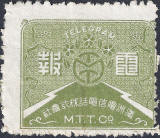 |
||||||||
|
The Manchurian Telegraph and Telephone
Company (满洲电信电话株式会社) used an olive coloured seal on telegrams.
To find out more about this click
here. Size 30mm x 25.5mm on unwatermarked white paper, no gum. Printers unknown. Rough perf 11.5, |
||||||||
|
|
||||||||
| Missionary Seals | ||||||||
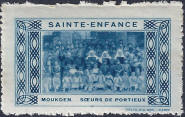
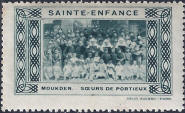
These seals are in support of a French Catholic missionary orphanage in Moukden. They were produced in France to raise money. It is probable they date from the mid 1930's it is not clear if they were used locally or sold in France to generate income. If anyone has any information would you please let me know. |
||||||||
|
|
||||||||
| For Airmail Labels see here | ||||||||

